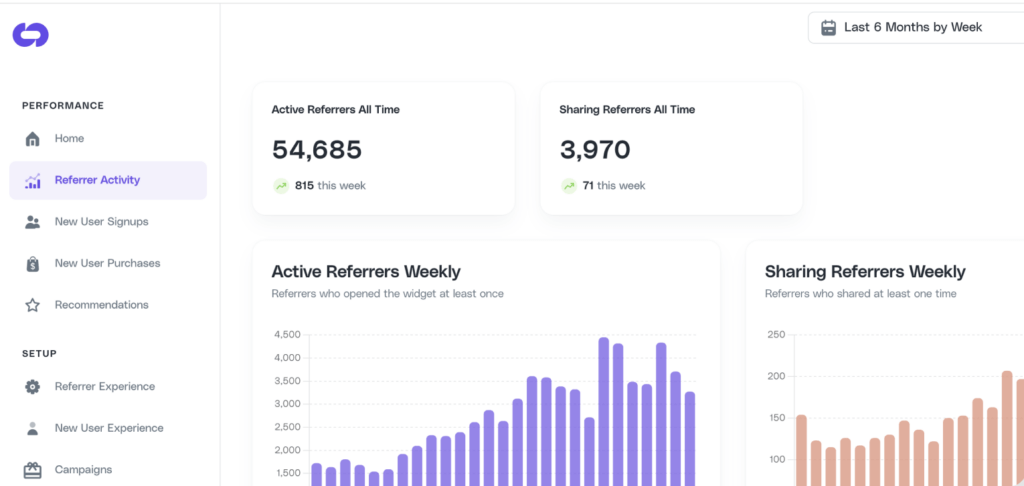A referral link is a crucial element in growth marketing and can significantly enhance the success of a business or brand. But what exactly is a referral link, and how does it operate? In this article, we will delve into the basics of referral links, explore their mechanics, highlight their benefits, discuss key considerations in using them, and address common misconceptions surrounding this powerful marketing tool.
| Key Element | Overview | Key Details | Strategic Importance |
|---|---|---|---|
| Definition and Purpose of Referral Links | Unique URLs for promoting through word-of-mouth. | Track referrals and rewards; increases acquisitions. | Crucial for measuring and rewarding referral success. |
| Role in Growth Marketing | Uses existing networks to boost business growth. | Builds trust and proof via referrer credibility. | Key for expanding customer base and gathering data. |
| Mechanics of Referral Links | Simple operation with unique identifiers for tracking. | Enables user action tracking and rewards referrers. | Helps integrate marketing tools for full campaign management. |
| Benefits of Using Referral Links | Effective for driving targeted traffic and boosting sales. | Leverages networks; provides engagement and conversion metrics. | Enables tracking and strategy optimization for better ROI. |
| Common Misconceptions about Referral Links | Often mistaken for tools used in scams. | Used ethically by legitimate businesses for growth. | Educating on legitimate uses can enhance participation and trust. |
Understanding the basics of referral links
Referral links are a fundamental aspect of growth marketing that businesses use to promote their products, services, or websites.
These unique URLs are assigned to individuals or businesses who want to leverage the power of word-of-mouth marketing.
By sharing referral links with their network, they can drive targeted traffic to a specific website, increase brand exposure, and potentially boost sales and conversions.
But what exactly are referral links and how do they work? Let's dive deeper into their definition and purpose.
Definition and purpose of referral links
🔗A referral link is a trackable link that allows businesses to monitor and measure the performance of their referral marketing campaigns. It serves as a bridge between the referrer and the potential customer/ new user.
When a user clicks on a referral link and completes a desired action, such as making a purchase or signing up for a service, the referrer is rewarded with incentives or commissions.
Referral links are not just random URLs; they are strategically designed to attribute the referral source. This attribution is crucial for businesses to identify the most effective referrers and optimize their marketing efforts accordingly.
Moreover, referral links serve as a win-win situation for both the referrer and the business. The referrer gets rewarded for their efforts in promoting the product or service, while the business benefits from increased brand visibility and potential customer acquisition.
Now that we have a clear understanding of referral links, let's explore their role in online marketing.
The role of referral links in growth marketing
In the vast world of growth marketing, referral links play a vital role in achieving marketing goals. They enable businesses to tap into the existing networks of their customers, followers, and influencers. By leveraging these relationships, businesses can effectively reach a wider audience and build trust with potential customers.
📈Referral links act as a powerful vehicle for businesses to expand their customer base. When a trusted source, such as a friend, family member, or influencer, shares a referral link, it adds credibility and social proof to the product or service being promoted. This social proof significantly increases the likelihood of a potential customer taking action and engaging with the offering.
Furthermore, referral links provide valuable data and insights for businesses. By tracking the performance of each referral link, businesses can identify which marketing channels, referrers, or campaigns are driving the most conversions. This data-driven approach allows businesses to optimize their marketing strategies and allocate resources effectively.
The mechanics of referral links
How referral links work
The mechanics of referral links are relatively straightforward. When someone receives a referral link, they can share it via various channels such as social media, email, or blog posts.
When a user clicks on the referral link, they are redirected to the website or landing page being promoted. The link contains a unique identifier that allows the business to track the source of the referral.

Once the user takes the desired action, whether it's making a purchase or signing up for a service, the referrer is credited for the referral. This can be done through automatic tracking systems or by using referral codes that users need to input during the ordering process.
Creating and sharing referral links
Creating and sharing referral links is relatively simple. Most businesses provide users with tools and resources to generate their unique referral links. These tools typically allow users to customize their links, track their performance, and access promotional materials.

When sharing referral links, it is essential to consider the target audience and appropriate channels. For example, sharing a referral link on a relevant social media platform or in a blog post can be an effective way to reach potential customers who are interested in the product or service being promoted.
| Mechanism Component | Description |
|---|---|
| Unique Identifier | Tracks the source with a unique ID for each referral link. |
| Creation of Referral Links | Users generate links via platforms that allow customization and tracking. |
| Sharing Methods | Shared through Social Media (Facebook, Twitter, LinkedIn), E-Mail, publishing on websites, blogs, and forums for maximum outreach. |
| Tracking and Analytics | Includes tracking clicks, conversions, and performance across platforms to guide strategy adjustments. |
| Rewards and Incentives | Offers incentives like discounts, cash back, or rewards points for successful referrals. |
| Automatic vs. Manual Tracking | Uses either automated link tracking or manual code entry to ensure referral attribution accuracy. |
| Integration with Marketing Tools | Seamlessly integrates with CRM, email marketing platforms, and analytics tools for cohesive campaign management. |
| Legal and Ethical Considerations | Emphasizes the need for transparency with users and compliance with data protection laws (GDPR, CCPA). |
Benefits of using referral links
Driving traffic with referral links
Referral links are an excellent way to drive targeted traffic to a website or landing page. By leveraging the existing connections of peers or influencers, businesses can tap into a diverse audience who are more likely to be interested in what they have to offer.
This targeted traffic can lead to higher engagement rates, longer time spent on the website, and potentially increased sales or conversions.
Boosting sales and conversions through referral links
One of the main benefits of using referral links is their ability to boost sales and conversions. When users receive recommendations from trusted sources, they are more inclined to make a purchase or take the desired action.
This is because referral links come with an element of trust and social proof, making potential customers more confident in their decision to engage with the product or service being promoted.
The benefits summarized:
- Targeted Traffic: Drives interested visitors via established connections.
- Higher Engagement: Leads to longer site visits and increased interaction.
- Boosted Sales/Conversions: Trusted recommendations encourage purchases.
- Trust and Social Proof: Builds confidence in potential customers.
- Cost-Effective: More affordable than traditional marketing.
- Easy to Track: Allows for simple performance monitoring and strategy optimization.
- Brand Awareness: Enhances brand visibility and reputation.
- Long-Term Relationships: Fosters loyalty and sustained customer engagement.
Key considerations in using referral links
Ethical practices in using referral links
When using referral links, it is crucial to adhere to ethical practices. Transparency is key, and it is essential to clearly disclose any potential incentives or commissions received through referral links.
This ensures that users are aware of the nature of the link and can make informed decisions regarding their engagement.

Additionally, it is important to only promote products or services that align with your values and that you genuinely believe will benefit your audience. By maintaining ethical practices, you can build trust with your audience, ultimately leading to more successful referral campaigns.
Tracking and analyzing referral link performance
To optimize the effectiveness of referral links, it is essential to track and analyze their performance. Businesses can use various tools and analytics platforms to monitor the metrics associated with each referral link.
By analyzing data such as activation rates, click-through rates, sign-up rates, purchase rates and customer behavior, businesses can identify areas of improvement and make data-driven decisions to enhance their referral marketing program.

Common misconceptions about referral links
Debunking myths about referral links
Despite the potential benefits of referral links, there are several misconceptions surrounding their use. One common misconception is that referral links are primarily used by pyramid schemes or scams.
However, legitimate businesses utilize referral links as an effective and ethical marketing strategy. It is important to distinguish between reputable businesses and fraudulent schemes.
Addressing concerns about referral links
Some individuals may have concerns about privacy and data security when it comes to clicking on referral links. It is crucial for businesses to prioritize the protection of user data and ensure that their referral links adhere to privacy regulations.
By addressing these concerns and providing clear information on data protection measures, businesses can help alleviate any apprehensions potential customers may have.
In conclusion, a referral link is a powerful marketing tool that allows businesses to tap into the networks of their customers, followers, and influencers.
By understanding the basics of referral links, their mechanics, benefits, key considerations, and debunking common misconceptions, businesses can effectively harness the potential of referral marketing to drive targeted traffic, boost sales, and cultivate meaningful relationships with their audience.
Transform your SaaS growth with Cello
Ready to turn your users into a powerful growth engine for your SaaS product? With Cello, implementing a peer-to-peer referral program is a breeze, allowing you to add this dynamic feature in just a few hours.
Experience the thrill of viral growth as your users share your product effortlessly, thanks to our seamless integration and user-friendly sharing options.
Enjoy the benefits of a 14% average free to paid conversion rate and a 10% average annual user-to-customer conversion rate. Our success-based pricing means you only pay when you see results, and with GDPR compliance and EU-based servers, your data security is assured.
Don't miss out on the opportunity to see how Cello can revolutionize your growth marketing strategy. Book a demo today and witness the power of user-led growth firsthand.
Resources
Related articles

4 Categories of Referral Programs for B2B SaaS
Learn how to get started with referral programs for B2B SaaS. Understand what type of referral ...

How to use incentives to drive velocity of your growth loops
This article is written together with Wes Bush, founder and CEO of ProductLed and one of the ...

Complete Guide to your B2B Referral Program
Want to get started with B2B referrals? Check out our complete guide to your B2B referral ...

